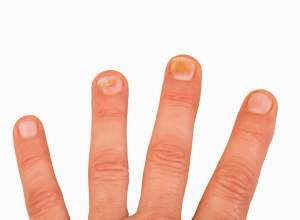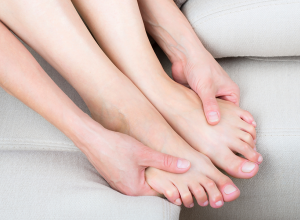
Beau’s Lines
QUICK FACTS
- Beau's lines are horizontal ridges that appear on fingernails and toenails
- The lines grow out when the nail lengthens, unlike similar conditions like Muehrcke nails
- Beau's lines are usually caused by a severe illness that temporarily stops nail production; examples include a nail infection, liver disease, diabetes or an extremely high fever
- You do not need to treat Beau's lines because they will grow out on their own. However, anyone with Beau's lines on their nails is advised to seek medical treatment, as the condition is often a sign of an underlying illness that likely needs medical attention and treatment
About Beau's Lines
Beau’s lines — first described by French physician Joseph Honoré Simon Beau in 1846 — are horizontal, grooved lines on a fingernail or toenail that run parallel to the lunula (the half-moon shaped whitish area that appears at the bed or proximal area of a nail). The deep ridges tend to eventually grow out as the nail lengthens, which can sometimes create pain if the misshapen nail presses deep into the flesh.
Beau’s lines are different from Mees' lines and Muehrcke nails, the latter of which affects the vascular nail bed and doos not grow out when the nail lengthens.
Causes
Beau’s lines are thought to be caused by a temporary cell division at the proximal base of the nail (in other words, the body stops producing nail cells for a specific period of time). This can be caused by a variety of systemic diseases and other conditions, including:
- A nail infection
- Trauma or an injury at the nail matrix
- Coronary occlusion and heart attack
- Hypocalcaemia
- Liver disease
- Severe infections of mumps, measles, pneumonia and other diseases
- Diabetes
- Certain skin diseases
- Malnutrition
- Chemotherapy drugs
- Kawasaki disease
- High fevers
- Malaria
- A change in altitude due to deep sea diving or mountain climbing
Because Beau’s lines grow out as the nail lengthens, the timing of when the nail injury or underlying disease can be determined by measuring the distance from the line to the nail’s proximal base.
Treatment
Beau’s lines will eventually grow out on their own, meaning there is no need for treatment of the lines. However, it is strongly recommended that you visit a doctor if you have Beau’s lines, as they may signify a serious underlying medical condition like the illnesses listed above.
Notice concerning medical entries:
Articles having medical content shall serve exclusively for the purpose of general information. Such articles are not suitable for any (self-) diagnosis and treatment of individual illnesses and medical indications. In particular, they cannot substitute for the examination, advice, or treatment by a licensed physician or pharmacist. No replies to any individual questions shall be effected through the articles.







